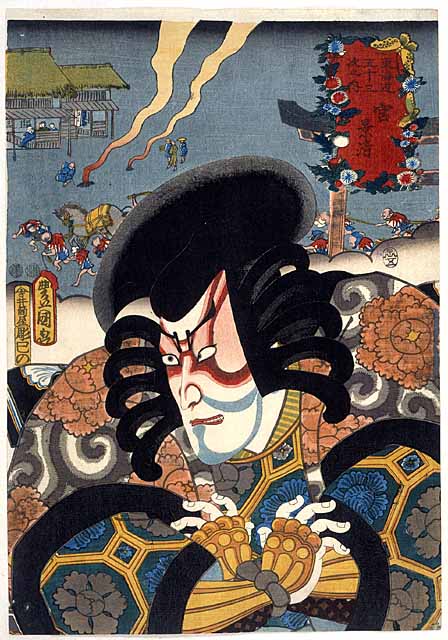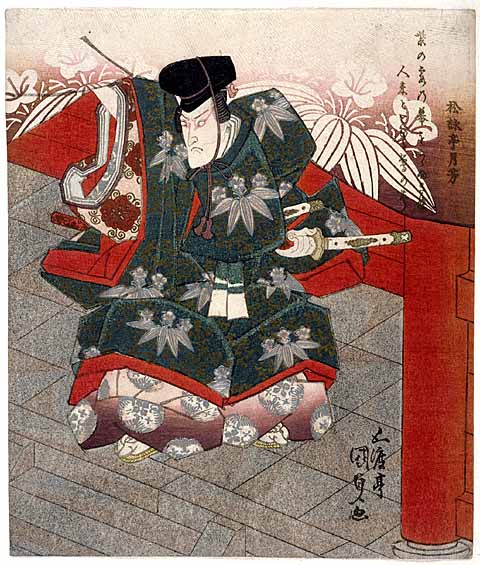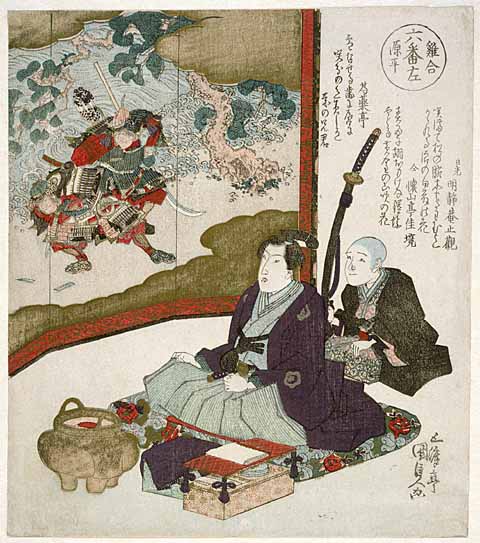
Miya Kagekiyo
05/1852
Given by the Friends of the Fitzwilliam with the aid of the MGC Purchase Grant Fund and the National Art Collections Fund.
A portrait of Ichikawa Danjuro VIII as Kagekiyo, with a view of Miya on the Tokaido Highway in the background, from the series Tokaido gojusan tsugi no uchi (Fifty-three stations of the Tokaido Highway).
Akushichibyoe Kagekiyo, a leading Heike warrior in the Gempei wars, featured only briefly in the historical chronicle Heike Monogatari (Tale of the Heike) but assumed great prominence in legend and in numerous kabuki and puppet dramas known as Kagekiyo mono (Kagekiyo plays). One version was included by Danjuro VII in his selection of Eighteen Plays (Kabuki Juhachiban) specially associated with the Ichikawa lineage. The role called for the Ichikawa speciality of aragoto (‘rough-stuff’) acting, with a dotera (padded-dressing-gown) costume, huge bushy wig and red make-up (beni suji) with suji gama (‘line shadows’) and painted blue beard (han guma).
As with all the prints in this series (two of them included here), the landscape in the background is heavily indebted to a print in Hiroshige’s famous series of Tokaido views published 20 years earlier.
Collections Record: P.60-1999

Bando Mitsugoro III as Shigetada (right) and Ichikawa Danjuro VII as Kagekiyo (left) in Kagekiyo c. 1826/7
Given to the Fitzwilliam Museum by E. Evelyn Barron in 1937 An interesting case where a surimono was produced for a play that was advertised but never performed. Kagekiyo was announced to open at the Ichimura theatre on the 9th day of the first month of 1827 with Danjuro VII as Taira no Kagekiyo, and Mitsugoro III as Hatakeyama Shigetada. However, the theatre burned down a few days before the opening and Danjuro VII was immediately recruited to perform at the Kawarazaki theatre in Sato no haru meibutsu amigasa (Famous sedge hats during spring in Yoshiwara).
Kagekiyo was the subject of several of the Eighteen Plays (Kabuki Juhachiban) selected by Danjuro VII as specially associated with the Ichikawa lineage of actors. Head samurai of the Taira clan, he was often presented as a master of the narrow escape, particularly in his failed attempts to assassinate Minamoto Yoritomo, head of the Genji clan. In this scene he disguises himself as a monk-soldier of the Todaiji temple in Nara, and waits for a chance to attack Yoritomo who is behind the curtain in the Great Buddha Hall officiating at the dedication of the newly restored temple in 1195. At this moment Yoritomo’s vassal, Shigetada, sees through the disguise. The design on the curtain and on Shigetada’s robe is the symbol of the Genji; the design on his pantaloons is Mitsugoro’s symbol.
The printing of this surimono employs a variety of exquisite effects, including the embossing of the texture of the billowing curtain, the metallic pigments on the armour, and the flecked pattern on the stone pavement which was sprayed through a bamboo straw. On some other impressions the seal of the printer Shunfudo Ryucho appears.
Collections Record: P.477-1937

Rokuban hidari Gempei (Number six, left: Gempei)
c. 1825
Given to the Fitzwilliam Museum by E. Evelyn Barron in 1937
From the series of fifteen Spring kyoka surimono entitled Niwatori-awase (A contest of fowls), commissioned by the Taiko poetry group for the year of the cock.
A young samurai (feudal lord) and attendant are depicted in front of a screen on which is painted the famous Shikoro biki (armour-pulling) incident from the Battle of Yashima, involving Minonoya Shiro and Kagekiyo, two of the leading warriors from the Gempei wars. Many of the Kabuki plays featuring the character Kagekiyo included a shikoro biki (armour-pulling) scene.
Collections Record: P.483-1937

Ichikawa Danjuro VII as a medicine seller in front of a cartouche of Danjuro IV as Kagekiyo
Given to the Fitzwilliam Museum by E. Evelyn Barron in 1937
This surimono is sealed beneath Kunisada’s signature with the artist’s sada seal in the form of the mimasu (triple-rice-measure) box which was the Ichikawa lineage acting crest (mon). It also bears the production seal of Kubo Shumman (1757-1820), indicating that Kunisada’s design was cut and printed by the Shumman studio. It was commissioned by the Go poetry group, whose stylised symbol made up of the character for ‘five’ (go) is used as the pattern on the upper part of Danjuro IV’s outer robe.
The surimono may have been intended as a memorial to Danjuro IV, and celebrates roles which were specialities of the Ichikawa lineage of actors. Kagekiyo was revived and revised by Danjuro IV and included by Danjuro VII in his selection of Eighteen Plays (Kabuki Juhachiban) specially associated with the Ichikawa lineage. The Ichikawa mimasu crest (mon) is seen on the hilt of Danjuro IV’s sword. He holds in a bag the precious biwa (lute) called Seizan, which Kagekiyo is hiding from his Genji enemies.
Danjuro VII is shown in the foreground holding a fan in one hand, which is embossed with the silver triple stripe (misuji) associated with the Ichikawa lineage. In the other hand he holds a medicine packet bearing the character uira[u], referring to the medicine uiro, which was supposed to cure everything from constipation to bad breath. The larger black case on his back has the characters for [O]dawara, the place where the medicine was produced. Uiro sellers were famous for their high-pitched voices and rapid sales-talk. Danjuro II, celebrated for his elocution, incorporated a uiro seller into a play on a Soga theme in 1718 (Wakamidori ikioi Soga), in which he is actually Soga no Juro in disguise. Danjuro VII wears the costume associated with this role: decorated with lucky coins and with a lining motif of sacred shimenawa ropes and dangling paper streamers. He later incorporated the role into a performance of Sukeroku yukari no Edo zakura (Sukeroku’s affinity for the cherry blossoms of Edo), in which he passed the Danjuro name onto his ten-year-old son, who became Danjuro VIII.
The poem on the surimono by Dokurakudo Takamori weaves into a standard New Year kyoka an allusion to the famed verbal gymnastics of the uiro seller, which in the play were supposedly due to the piece of uiro that he had put into his mouth:
Saku ume no With the scent of plum kaori fukumeba blossoms filling its mouth, ima masa ni the warbler in the courtyard shita yoku mawaru is now readied to recite yado no uguisu its elegant tongue-twisters.
(translation by John Carpenter)
Collections Record: P.493-1937



